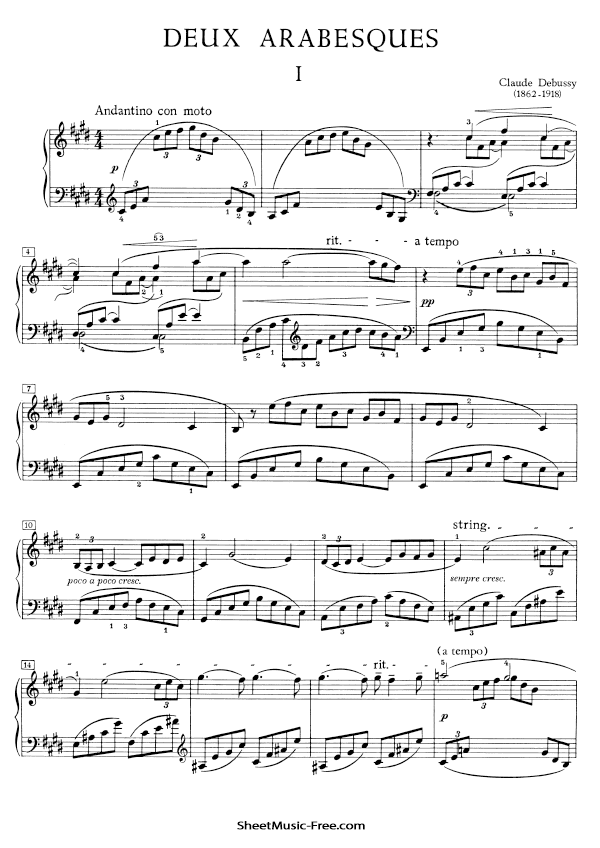
Image: Portrait of Claude Debussy.
At 9 years old, Debussy demonstrated skill in piano playing. He began studying piano and composition at the Paris Conservatory in 1873 (when he was 11 years old). Years later, in 1884, he entered his cantata L'Enfant prodigue (The Prodigal Child) into the Prix de Rome, a competition for composers. He won a prestigious art scholarship which allowed a young French artist to study at the Académie de France in Rome.
During his youth, he was able to travel around Europe with Nadezhda von Meck, a supporter of Tchaikovsky who hired him to teach piano to her children. Additionally, he acquired various musical and cultural experiences during his time in Russia.
Though the scholarship allowed him to study in Rome for 3 years, he fled the Villa Medici (which housed the Prix de Rome winners) 2 years into the program -- he wasn't too satisfied with the conditions there. He fled back to Paris to be with Blanche Vasnier, a beautiful, young married singer who he fell in love with. However, he was also involved with other women. One of his mistresses and his first wife both attempted suicide. Debussy himself became overwhelmed with suicidal thoughts. It has been said that hardships like these contributed to his early style of music, and the style is evident in one of his most well-known compositions, Clair de lune.

Image: Depiction of Clair de lune.
INSPIRATION, ASPIRATIONS, & CREATIVE PROCESS
Debussy found himself to be inspired heavily by German composer Richard Wagner. According to Lockspeiser on Encyclopedia Britannica, "Wagner fulfilled the sensuous ambitions not only of composers but also of the Symbolist poets and Impressionist painters... [he] encouraged artists to refine upon their emotional responses and to exteriorize their hidden dream states" (2019). This idea of exteriorization came to be known as the Wagnerian technique.
Debussy's aspirations thus involved wanting to paint images with music. Throughout the course of his career, he explored other artistic domains, particularly painting and poetry. In addition, he was amazed by a Javanese gamelan (a traditional Indonesian instrumental ensemble consisting of bells, gongs, xylophones, etc.) at the 1889 Paris World Exposition. With this, Debussy incorporated components of the gamelan as well as the aforementioned Russian musical styles into his works.
Rather than writing music on a desk or outside, as most artists would, he came up with music as he played the piano. Thus, Debussy's pieces consisted of improvisation and spontaneity -- it was evident that he simply played what he felt. Léon-Paul Fargue, a poet who observed Debussy's piano playing, described Debussy's process as "[giving] the impression of delivering the piano of its song... like a mother of her child" (Hough, 2018). And, as Hough very well puts it, "the cascading arpeggios [in his music] are like liquid running through the fingers, all shimmer and sparkle" (2018). Particularly, in one of his piano suites titled Children's Corner (1908), he demonstrated having an "acute insight into the child mind", and one can quite imagine children's toys in a room when listening to the suite (Lockspeiser, 2019).

Image: Debussy's Arabesque No. 1, which is known for its beautiful, free-flowing arpeggios.
ANALYSIS
Overall, I would say that Claude Debussy is a big-C creative, for his musical works serve as a foundation for the works of other musicians even to this day. He was among the first to incorporate "illusions" into his pieces, making him the founder of musical impressionism. It is also important to note that his modes of composition "later [on became more] developed in the styles of Stravinsky", a classical composer who Howard Gardner believes to be suitable to support the musical-rhythmic component of his Multiple Intelligence Theory (Lockspeiser, 2019). Debussy also challenged stereotypical harmonic procedures during his time and the traditional orchestral usage of instruments. For example, his Cello Sonata involves a bass instrument taking the role of a violin, flute, and mandolin. In other words, Debussy saw potential in every instrument and believed that they're not limited to playing classical music.
As for motivation, it is not clear as to whether he was extrinsically motivated -- there was likely a combination of both. He was encouraged by Madame Mauté de Fleurville (who was associated with Frédéric Chopin) to start taking piano lessons in the first place, but there was no indication that he later on only sought fame through his musical career.
---
References
Lockspeiser, E. (2019, August 18). Claude Debussy. Retrieved from https://www.britannica.com/biography/Claude-Debussy
Biography. (2015, April 22). Claude Debussy Biography. Retrieved from https://www.biography.com/musician/claude-debussy
Hough, S. (2018, March 2). 100 Years After Debussy's Death, He Remains the First 'Modern' Composer. Retrieved from https://www.nytimes.com/2018/03/02/arts/music/debussy-stephen-hough.html
Image sources:
https://en.wikipedia.org/wiki/Claude_Debussy
https://mymemorymatters.org/clair-de-lune/
https://sheetmusic-free.com/arabesque-sheet-music-debussy/
I love listening to Debussy when I study, but I didn't know anything about his career. I did not know that musical impressionism even existed, though I suppose I should not be surprised. It was an incredibly interesting read!
ReplyDeleteDebussy is one of my favorite composers. His composition style somewhat reflected the impressionist music style on his time, but Debussy firmly called his composition style symbolism and, later, modernism. I definitely agree that Debussy is a Big-C creative. His composition style changed the way other composers and listeners interacted with music and sound.
ReplyDeleteI personally love Debussy and have played several of his works in my years of playing piano. I love that some of his works were written as improvisations--I know one that I played (Doctor Gradus ad Parnassum) was written as a technique exercise of sorts. After studying Stravinsky a bit this semester, I also agree and see the connection between Debussy's early impressionism and Stravinsky's full on 20th century music. Debussy is definitely more tonal and rhythmically conventional than is Stravinsky.
ReplyDelete